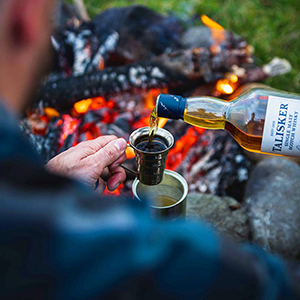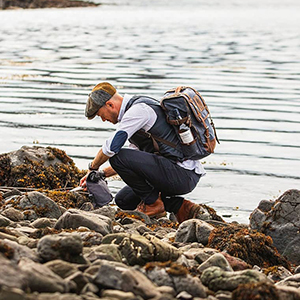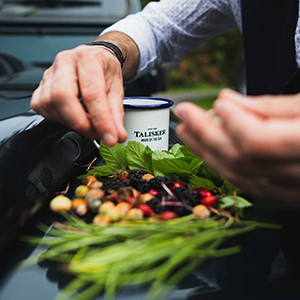Talisker ambassador Jason Clark has, for my money, one of the most interesting drinks-related accounts on Instagram.
His photography is invariably beautiful and the drinks he showcases are generally anything but run-of-the-mill. And beyond that, at least pre-Covid, it is the locations he selects for cocktail-creation shoots that I find interesting – often choosing wild, outdoor places over the standard ambassador-in-a-swanky-bar fair we are used to seeing on Insta. I spent a very pleasant half hour interviewing Jason via Zoom last week, and I led with a question about his obvious love of the outdoors.
BLUK: Many of your Instagram posts are shot on beaches in wild places. What attracts you to making cocktails out in the elements?
 JC: I’ve always had a passion for the outdoors, growing up in New Zealand. If I wasn’t in the bar industry, I’d probably be doing something in the outdoors industry, guiding, mountaineering or outdoor photography. I’ve always loved the adventure lifestyle. I was actually training for that when I was younger, and then I got caught by the hospitality bug and fell in love with that… And I guess in recent years I’ve been heading back into the outdoors a lot more, and I’ve been so blessed and so lucky to work with a brand that feels so connected with that world. It’s allowed me to try and bring the two worlds together and explore that side more and more. Now that I’m in my 40s I find it so nice to balance nightlife and drinking with getting in the outdoors and attempting to stay fit.
JC: I’ve always had a passion for the outdoors, growing up in New Zealand. If I wasn’t in the bar industry, I’d probably be doing something in the outdoors industry, guiding, mountaineering or outdoor photography. I’ve always loved the adventure lifestyle. I was actually training for that when I was younger, and then I got caught by the hospitality bug and fell in love with that… And I guess in recent years I’ve been heading back into the outdoors a lot more, and I’ve been so blessed and so lucky to work with a brand that feels so connected with that world. It’s allowed me to try and bring the two worlds together and explore that side more and more. Now that I’m in my 40s I find it so nice to balance nightlife and drinking with getting in the outdoors and attempting to stay fit.
I find Talisker connects really well with the outdoors lifestyle, so having a dram in the woods, by a river or on the sea-side creates an extra special moment, it all just works. I now do it so often I’ve dubbed it “Adventure Dramming!”
BLUK: So was that your idea to bring exploration of the outdoors to the role of Talisker ambassador?
 JC: I think the brand has been marketing along those lines for a long time. I noticed on social media a lot of people were taking photos of bottles outside, with Autumn leaves and whatnot and I guess I’ve just accentuated that and brought it into my role. As a brand ambassador it certainly wasn’t in the job description. I’ve just really taken that onboard and tried to bring it into the role and it seems to have really worked… And Talisker is celebrating 190 years this year, it’s been around since 1830, and long before any of us were around, it was known as a whisky that showcased the environment from which it is made. It’s distinctly unique and when you pour a dram, you can the smell the salty, briny maritime character… We love to talk about that and our connection with the sea, and we are a big brand, all over the world, so it makes sense that we give back to that cause.
JC: I think the brand has been marketing along those lines for a long time. I noticed on social media a lot of people were taking photos of bottles outside, with Autumn leaves and whatnot and I guess I’ve just accentuated that and brought it into my role. As a brand ambassador it certainly wasn’t in the job description. I’ve just really taken that onboard and tried to bring it into the role and it seems to have really worked… And Talisker is celebrating 190 years this year, it’s been around since 1830, and long before any of us were around, it was known as a whisky that showcased the environment from which it is made. It’s distinctly unique and when you pour a dram, you can the smell the salty, briny maritime character… We love to talk about that and our connection with the sea, and we are a big brand, all over the world, so it makes sense that we give back to that cause.
We’ve got two initiatives, one is Parley, which is an environmental initiative which is about re-wilding the seas, removing plastic, and particularly for us, helping kelp forests which are essential for the ecosystem. We are working to re-wilding 100 million square meters of marine ecosystems, in Scotland and international locations as well.
The other big one we do is the Talisker Whisky Atlantic Challenge, it’s been around for a long time. It’s the world’s toughest rowing race, which goes from the Canary Islands to Antigua, it’s 3000 miles… Rowers from all over the word team up, each works with different charities and many of these will be environmental charities. Talisker is the main sponsor to run the competition, but it brings all these other charitable trusts to give back to the environment and give back to the sea.
BLUK: Are there any places you visited before Covid closed travel down that stuck in your mind as being a favourite, or particularly beautiful?
I just can’t go past Skye and Scotland. I had some great times down in Cornwall, and between Brighton and Bournemouth. The Jurassic Coast. Lots of great, great experiences, but Skye for me tops it all. Coming from New Zealand I can see a lot of comparisons and similarities to the Highlands, particularly Skye, so I just really feel at home up there…. Skye is the ultimate for me, even though I’ve been up there a dozen times, there’s still so much to explore and I can’t wait to go back for more.
BLUK: Some of your Instagram posts show you using foraged ingredients. How did you get started with that?
JC: Making drinks with a “Made By The Sea character” (as done in a cocktail competition previously staged by Talisker) is a great challenge, but it’s really tough to make a creative drink with maritime flavours that isn’t just something with a touch of salt & seaweed in it. And seaweed probably isn’t the most appealing flavour people go for in a cocktail menu, so my idea was to open it right up. At Talisker, we talk about the wild spirit of the environment on Skye, and of the people who produce the liquid, so the challenge I created was for bartenders to create a ‘wild spirit’ cocktail that showcases the flavours of the great British outdoors… I think of wild spirit cocktails as a category, like Tiki. With Tiki you are getting the escapism of tropicana, the Caribbean and the pacific. With wild spirit cocktails, I envision drinks that showcase the Great British outdoors, giving guests an escape from their bar stool in the city to give them a taste of the wild, through the cocktails name, story, ingredients, smell taste and presentation.
BLUK: When using foraged ingredients, there are obviously some techniques and concerns that you need to have, so did you do some learning, and if so, where did you find that learning?
 JC: You’re 100% right there. In terms of foraging, in the past with my travels and adventures I’ve always loved identifying plants and trees on hikes, I felt like I was quite up with the play in New Zealand, but it is very different here, so I teamed up with a few different foragers over the last few years. One guy in particular called John Rensten, he’s the owner of the Forage London website, and he wrote the book Edible City, which basically runs a calendar year – January to December – so we are talking seasonal, exploration of parks all over London… even in harshest months of winter when you think things aren’t growing, he’ll tell you that even in tiny little parks he’ll showcase a broad variety of ingredients you can utilise. I connected with him in person, he took me out and talked about safety, there are some rules you should always abide by. You’ve got to 100% know that what you’re picking and putting in a food item is edible, and from a location or a source that’s clean & safe. You know, there could have been spraying there, it could be an old factory site or be contaminated by animals or people. So knowing those rules is very important.
JC: You’re 100% right there. In terms of foraging, in the past with my travels and adventures I’ve always loved identifying plants and trees on hikes, I felt like I was quite up with the play in New Zealand, but it is very different here, so I teamed up with a few different foragers over the last few years. One guy in particular called John Rensten, he’s the owner of the Forage London website, and he wrote the book Edible City, which basically runs a calendar year – January to December – so we are talking seasonal, exploration of parks all over London… even in harshest months of winter when you think things aren’t growing, he’ll tell you that even in tiny little parks he’ll showcase a broad variety of ingredients you can utilise. I connected with him in person, he took me out and talked about safety, there are some rules you should always abide by. You’ve got to 100% know that what you’re picking and putting in a food item is edible, and from a location or a source that’s clean & safe. You know, there could have been spraying there, it could be an old factory site or be contaminated by animals or people. So knowing those rules is very important.
BLUK: That brings us nicely to seasonal flavours. As we move into winter now, what do you consider to be winter flavours, and how do you express those in a cocktail?
JC: A lot of the winter flavours we associate with whisky and whisky cocktails aren’t local, you’re probably thinking of cinnamon, spices, coffee, chocolate. They’re not necessarily local, so when you do look local to find ingredients, seasonality is very different depending on where you are in the world, in the country. Ingredients that come to mind are hazelnuts, they grow wild in Skye, chestnuts, wood sorrel, which gives you green apple flavours… fruits and flowers are more summer. In winter you are looking more to leaves, nuts and even roots.
Fig leaf has been one that’s popping up a lot recently, the guys at Scout use it a lot. Two hundred meters from my house, walking to the shops, there’s a big fig tree that hangs over the footpath, so I can grab a few leaves on the way home each time. And they can give you flavours like coconut, sarsaparilla, and this lovely herbal note which is all quite different to what you might expect.
BLUK: What you’ve just described there, of grabbing some leaves on the way home is the essence of locality, and using what’s around you. What do you think doing something like that brings to a bar menu, for a cocktail menu?
JC: Well first of all, safety first. Don’t piss off your neighbours, stealing their roses and whatnot! But what I think it really brings is storytelling to the guest, a real connectivity to the local environment by telling that story of ‘on my way home I picked up fig leaf and pineapple weed, and rosemary, which is in your drink, and these are local, sustainable, wild flavours from this area’. I think that brings a real connection for the guest and it’s a lovely story… Scout do that incredibly well, they work with a local forager who is a local expert, so he’s sourcing for them. They develop their own skills by working with that local supplier.
BLUK: Can think of that has a base or a foundation that you can tweak seasonally as the year goes by, giving the drink different expressions as the year goes on?
JC: Absolutely. All the rage right now is the Highball. Now a Whisky Highball is typically whisky and soda, and that soda has normally got a sweet / sour flavouring agent, so ginger ale would be ginger flavour with acid and sugar. You can substitute all of those elements by making a cordial, so whisky with a ‘forager’s cordial’ and soda. That forager’s cordial can change seasonally, so you might be using elderflower and nettle in the Spring and Summer…. Whereas in winter I might be using things like pine, and wood sorrel, and once again you balance it with sweet and acid, and it gives you these real herbal notes. So I call it a Forager’s Highball, which uses a foragers cordial, which changes as you run out of each batch, basically.
 BLUK: Do you have a Christmas drink that you particularly like? Something that someone outside the industry or a bartender would equally enjoy?
BLUK: Do you have a Christmas drink that you particularly like? Something that someone outside the industry or a bartender would equally enjoy?
JC: I would probably make them a Talisker Hot Toddy or a Talisker Hot Spiced Cider, with apples, spices, honey, Talisker. Served nice and hot, it’s really warming…. You can batch it up and keep it cold, then heat it up to order.
BLUK: So in the last few weeks, vaccines have been rolled out and it looks as though some semblance of normality could return in the Spring next year. What are you most looking forward to doing when and if that happens?
JC: My ultimate would be to get back on the road, touring the UK in the Talisker Land Rover, sharing knowledge and cocktail inspiration with bartenders all over the country. The first chance I get I will be up to Skye, and then making my way down as far South as I have time to go. When I go up I often get to do a shift at the distillery which is such a great experience, and then heading South I try to connect with as many bartenders as I can along the way. I can’t wait, that would be the ultimate for me.
I thoroughly enjoyed speaking to Jason about his travels and thoughts on seasonal flavours and foraging. He is an interesting chap, and when things get back to normal, should you have the opportunity to attend one of his Talisker tastings or masterclasses, I recommend you take it. Until then, here are the specs for the drinks Jason mentions in the interview, so you can make them at home or in your bar, while imagining you are in the wilds of Skye…
Jason’s Winter Drinks Recipes
Hot Smoky Cider – Serves 5
250ml Talisker 10yo, Skye or Storm
1L Cloudy apple juice or apple cider
75ml Honey (dependent on the sweetness of your apple)
150ml water
1x Cinnamon quill
1x Star anise
Grated nutmeg
5x Dash Angostura bitters
½ Barspoon Pure vanilla extract
Apple slices *optional
Add all except the Talisker to a saucepan and bring to a boil while stirring then pour into mugs. Once cooled to approximately 70c add the talisker & stir. *In a bar environment, simply steam this mixture with the milk wand on the coffee machine.
Garnish: Apple slice, star anise & ½ a cinnamon quill.
Foragers Highball
50ml Talikser Talisker 10yo, Skye or Storm
30ml Foragers cordial
Soda
Build over ice in a highball glass
Garnish: Fresh leafy botanical of some kind EG. Pine, mint, rosemary etc.
Foragers Cordial
40g/2 oz Pine needles – *Make sure you’ve identified the tree correctly. Some variety’s can be toxic and pick youngest freshest needles
30g Wood Sorrel leaves – Tastes like green apple
500ml Boiling water
225g Sugar
16g Citric &/or Malic Acid *may need more or less depending on the botanicals used.
Method
Make a syrup by adding boing water to the pine, sorrel & sugar. Allow to cool completely and then fine strain & balance the sweetness adding in the acid. Decant into sterilised bottles, label & refrigerate. This will remain shelf stable for months if kept chilled.
*Tip: Feel free to substitute these botanicals with other herbal options that will match these flavours. Spent citrus husks and mint stems can also be great additions.


